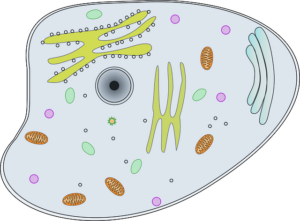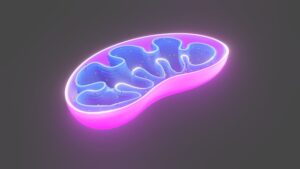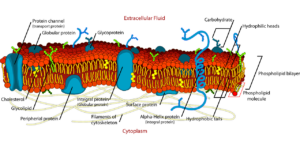Cytoplasm is the whole semifluid of the cell, enclosed by the cellular membrane except the nucleus. It consists of cytosol, the cellular organelles and various kinds of cytoplasmic inclusions. Cytoplasm function in animal cells are-
- The cytoplasm holds all the components of a cell. All the cellular organelles remain embedded in it.
- The cytoplasm contains many chemical compounds including enzymes which play major roles in breakdown of cellular wastes.
- Cytoplasm assists various biochemical reactions like cellular respiration and helps in the glycolysis process.
- Cytoplasm produces cytoskeleton, a protein rich filamentous system which provides a shape to the cell.
- It holds all the cellular organelles in their correct positions.
- The cytoplasm consists of various ions. By moving them towards their destination ,cytoplasm also helps signaling pathways.
- A large part of m-RNA translation takes place in cytoplasm, it assists the protein synthesis process.
- Cytoskeleton accelerates movement of particles and removes all the foreign particles from the cell.
- Cell expandation and cell growth strictly depends on cytoplasm.
- Cytoplasm is a buffer which gives protection to the cell and its genetic material during the movement or collision with other cells.
- Some cytoplasmic organelles like chloroplast, mitochondria have their own genetic material. The gene transmission process is totally independent from the nucleus. It is controlled by the cytoplasm and hence called cytoplasmic inheritance.
The cytoplasm is the home of all cellular activities. In 1863, a Swiss anatomist, physiologist, and histologist sir Rudolf von Kölliker first used the term cytoplasm as a synonym of protoplasm.
To know about DNA replication read on DNA Replication Steps and Critical FAQs

Animal cell from pixabay
Chemical Composition Of Cytoplasm
Cytoplasm is a gelatinous semifluid of a cell. Cyto means cell and plasm means stuff, so together it’s cell staff. The main function of Cytoplasm is to hold all the cellular organelles in it.
Cytoplasm is basically made up of water (80%-85%), proteins (10%-15%), lipids (2%-4%), inorganic salts and polysaccharides.
It has various micro elements in it. According to research it is consist of oxygen (62%), carbon (20%), hidrogen (10%), nitrogen (3%), calcium (2.5%), phosphorus (1.14%), chlorine (0.16%), sulfur (0.14%), potassium (0.11%), sodium (0.10%), magnesium (0.07%), iodine (0.0014%) and iron (0.10%).
Apart from that it also has very less amount of copper, cobolt, manganese, zinc, molybdenum, boron, silicon, etc.
With this chemical Composition cytoplasm also consists of various enzymes, nucleic acids, and amino acids in it.
Structure Of Cytoplasm
Cytoplasm is a viscous substance which functions as a platform for all cellular biochemical activities. As we all know the cytoplasm consists of cytosol, all the cell organelles and some cytoplasmic inclusions. There are majorly two parts of cytoplasm such as-
Let’s have a closer look on the properties of ectoplasm and endoplasm.
Ectoplasm
Ectoplasm is also called exoplasm. The ancient Greek word ἐκτός (èktòs) means outside and the word plasma stands for something formed. The ectoplasm is the outer peripheral part of the cytoplasm. It is the non- granulated and clear. It has a watery kind of physical nature. The function of ectoplasm is mostly to give protection and help in cellular transportation at this part (specially for amoeboid cells). The ectoplasm also contains actin and myosin filaments, which give rigidity and support to the cell membrane.
Endoplasm
Endoplasm is the inner granulated dense part of the cytoplasm. It consists of several granules, nucleic acids, amino acids, water, sugar, fatty acids, inorganic ions, etc. It assists most of the metabolic activities in the cell. It contains all the cellular organelles, and hosts the endomembrane system of the cell.
In the case of amoeboid cells one of the major cytoplasm functions is pseudopodia formation and the acceleration of the movement mechanisms.
Components Of Cytoplasm In Animal Cells
In simple words Cytoplasm is nothing but the non nuclear component of protoplasm. Here we describe the components of cytoplasm in animal cells. There are three major components of the cytoplasm.
Let’s have a closer look on these components of Cytoplasm respectively
Cytosol
Cytosol is the intracellular fluid, cytoplasmic matrix which holds all the organelles. In 1965, H. A. Lardy first introduced the term cytosol.
It is composed of various water dissolved substances like chemical ions, protein molecules, etc. It is made up of 70% of water, some amount of
Potassium, Sodium, Chloride, Bicarbonate, Magnesium, and Calcium ions. The cytosolic elements like actin filaments and some microtubules form the cytoskeleton which gives the cell rigidity. The function of cytosol is to transport metabolites from one place to another. It helps in cell signaling pathways.
Cellular organelles
The cellular organelles are membrane bound subunits of the cell. These cellular subunits have their own specific functions. There are several cellular organelles, which make up the endomembrane systems. Let’s discuss some major cellular organelles with their specific functions in eukaryotic animal cells.
- Cell membrane is one of the major organelles, which separates the intracellular environment from the outside. It protects the cell and helps in transportation mechanisms.
- Endoplasmic reticulum are the single membrane compartments. There are two different types of ER found such as Smooth Endoplasmic Reticulum (without attached ribosomes) and Rough Endoplasmic Reticulum (with attached ribosomes).
- Flagellum is a protein made locomotory organ found in some eukaryotes.
- Golgi apparatus helps in protein sorting, packaging, and processing mechanisms. It plays an important role in modification of protein molecules.
- Mitochondria is the powerhouse of a cell, which produces energy by oxidation of glucose substances in the cell. It is a double membranous compartment having its own genetic material in it.
- Vacuole is the storage element of a cell. It is mainly a single membrane compartment which is very necessary for cellular transportation. It also helps in homeostasis.
- Lysosome is a membrane bound cell organella known as suicidal bag. It contains digestive enzymes in it which is responsible for breakdown of large cellular molecules.
- Ribosomes (80S) is a protein substance which is known as the protein factory of the cell. It plays a major role in the RNA translation process.
- Centriole is a microtubular protein substance present in the cytoplasm of most animal cells. It helps in the cell division process by forming spindle fibers.
- Vesicles are single membrane compartments that help in the cellular material transportation process.
- Peroxisome is a single membranous cell organelle mostly known for its role in breakdown of hydrogen peroxide within an Eukaryotic cell.
- Cilia is a microtubular protein substance that helps in locomotion.
- Acrosome is a single membrane compartment present in animal’s reproductive cells. It helps the spermatozoa to fuse with the ovum.

Mitochondria by pixabay
Apart from these eukaryotic cells also have some minor cellular organelles like melanosomes, autophagosomes, miofibril, stress granules, etc.
Cytoplasmic inclusions
Cytoplasmic inclusions are non living small particles present in cytosol such as calcium oxalate, silicon dioxide, lipid droplets, adipocytes, glycogen, starch granules, etc.
To know more about Eukaryotic cells read on Eukaryotic Cells Examples: Detailed Insights
Chemical Composition Of Cytoplasmic Membrane
Cytoplasmic Membrane or cell membrane is a biological membrane between the outer and inter cellular environment. It protects the cell from external mechanical injuries. It is composed of various biological components such as-
Lipids
According to RBC studies, about 30% of plasma membrane is made up of lipid substances. The cell membrane contains three major types of amphiphilic lipids, such as phospholipids, glycolipids and sterols. About 50% of lipids are generally phospholipids, 2% are glycolipids and the rest are sterols in cell membranes.
Carbohydrates
Cytoplasmic membrane contains carbohydrate substances mostly glycoproteins with some amount of glycolipids. The carbohydrates are important for the cell cell recognition process.
To know more about Carbohydrates read on Carbohydrates Structure Examples: Detailed Insights
Proteins
About 50% of cytoplasmic membrane consists of various protein molecules. There are mostly three types of proteins present in cell membrane such as integral proteins, peripheral proteins, and lipid-anchored proteins.

Cytoplasmic membrane from pixabay
Cytoplasmic Membrane Structure In Animal Cell
To describe the structure of cytoplasmic membrane in animal cells, fluid mosaic model can be studied.
Fluid Mosaic Model
In 1972 American cell biologist Seymour Jonathan Singer and biochemist Garth L. Nicolson first proposed the fluid mosaic model of cell membrane.
According to this phospholipid bilayer is formed which acts as a barrier. Between the phospholipid layers the protein is embedded. Cytoskeleton is also present in cell membrane.
How Does The Cytoplasm Function In Animal Cell?
The cytoplasm primarily holds all the cellular organelles and supports their activities. It is the house of all cellular activities.
The Cytoplasm embeds all the cellular organelles. Cytoplasmic enzymes help in breakdown of cellular wastes. By producing cytoskeleton it brings rigidity to the cell. The filamentous cytoskeleton helps to stick organelles in their correct positions. It assists various biochemical activities like glycolysis, m-RNA translation and protein synthesis process, etc. It helps in removing the foreign particles by moving them towards their destination.
As a whole we can say cytoplasm is the heart of the cell. We know about the cytoplasm function in animal cells. We discuss all the composition of cytoplasm and also know the structure of it. We also describe the composition and structure of cytoplasmic membrane in this article.
Also Read:
- Function of plasmid in bacteria
- Function of cytoplasm in bacteria
- Smooth endoplasmic reticulum function
- Cytoplasm function
- Function of cytosine
- Adenine function in rna
- Chromosome functions in animal cell
- What is the function of ribosomes
- Rna splicing function
- Anticodon function

Hello, I am Piyali Das, pursuing my Post Graduation in Zoology from Calcutta University. I am very passionate on Academic Article writing. My aim is to explain complex things in simple way through my writings for the readers.